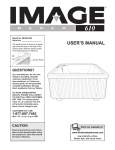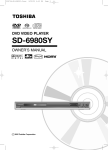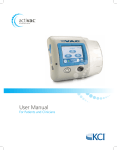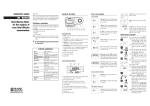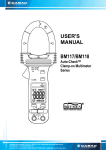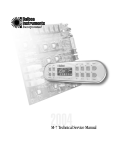Download Important - Nature Spa
Transcript
50 Hz Technical Service Manual Table of Contents Balboa Control Service Checklist Preface . . . . . . . . . . . . . . . . . . . . . . . . . . . . . . . . . . . .3 Tools Required . . . . . . . . . . . . . . . . . . . . . . . . . . . . . .3 System Components Required . . . . . . . . . . . . . . . . . . .3 Safety Tips . . . . . . . . . . . . . . . . . . . . . . . . . . . . . . . . .3 System Description Topside Control Panel . . . . . . . . . . . . . . . . . . . . . . . . .4 Circuit Board . . . . . . . . . . . . . . . . . . . . . . . . . . . . . . .4 Temperature Sensor . . . . . . . . . . . . . . . . . . . . . . . . . .4 High-limit Sensor . . . . . . . . . . . . . . . . . . . . . . . . . . . .4 Wiring Checks Wiring Check Precautions . . . . . . . . . . . . . . . . . . . . . .5 System Box Wire Gauge Check . . . . . . . . . . . . . . . . . . .5 R.C.D. Wiring Check . . . . . . . . . . . . . . . . . . . . . . . . . .5 R.C.D. Line-in Wiring Check . . . . . . . . . . . . . . . . . . . .6 R.C.D. Line-out Wiring Check 230 V Dedicated . . . . . . . . . . . . . . . . . . . . . . . . .6 Voltage Checks Breaker Box Voltage Check . . . . . . . . . . . . . . . . . . . . .7 R.C.D. Line-in Voltage Check 230 V Dedicated . . . . . . . . . . . . . . . . . . . . . . . . .7 R.C.D. Load Out Voltage Check 230V Dedicated . . . . . . . . . . . . . . . . . . . . . . . . .7 System Box Check (at TB1) 230 V Dedicated . . . . . . . . . . . . . . . . . . . . . . . . .7 Peak Load Check . . . . . . . . . . . . . . . . . . . . . . . . . . . .7 Peak Load Check for 230 V Dedicated . . . . . . . .7 Wiring Schematic . . . . . . . . . . . . . . . . . . . . . . . .8 Test the System, Pump . . . . . . . . . . . . . . . . . . . . . . . .9 Test the Blower . . . . . . . . . . . . . . . . . . . . . . . . . . . . .10 Test the Amperage Draw . . . . . . . . . . . . . . . . . . . . . .10 Test the Soldered-in Fuse . . . . . . . . . . . . . . . . . . . . .10 Transformer Installation Requirement . . . . . . . . . . . .11 Topside Control Panel Preliminary Panel Check . . . . . . . . . . . . . . . . . . . . . .12 Bulb Replacement . . . . . . . . . . . . . . . . . . . . . . . . . . .12 Remote Panel Troubleshooting . . . . . . . . . . . . . . . . .12 Panel Messages OH . . . . . . . . . . . . . . . . . . . . . . . . . . . . . . . . . . . . . .13 SN1 . . . . . . . . . . . . . . . . . . . . . . . . . . . . . . . . . . . . .14 SN3 . . . . . . . . . . . . . . . . . . . . . . . . . . . . . . . . . . . . .14 FLO (Continuous and Flashing) . . . . . . . . . . . . . . . . .14 COOL . . . . . . . . . . . . . . . . . . . . . . . . . . . . . . . . . . . .15 ICE . . . . . . . . . . . . . . . . . . . . . . . . . . . . . . . . . . . . . .15 Pd . . . . . . . . . . . . . . . . . . . . . . . . . . . . . . . . . . . . . .15 O3 . . . . . . . . . . . . . . . . . . . . . . . . . . . . . . . . . . . . . .15 pH50 . . . . . . . . . . . . . . . . . . . . . . . . . . . . . . . . . . . .15 pH90 . . . . . . . . . . . . . . . . . . . . . . . . . . . . . . . . . . . .15 ILOC . . . . . . . . . . . . . . . . . . . . . . . . . . . . . . . . . . . . .15 Unexplained Error Messages . . . . . . . . . . . . . . . . . . .15 Pressure Switch Calibration . . . . . . . . . . . . . . . . . . . .15 Continuous FLO . . . . . . . . . . . . . . . . . . . . . . . . .15 Flashing FLO . . . . . . . . . . . . . . . . . . . . . . . . . . .16 R.C.D. Troubleshooting If Correct Wiring is Verified . . . . . . . . . . . . . . . . . . . .17 To Disconnect the Heater . . . . . . . . . . . . . . . . . . . . .17 Basic Control System Troubleshooting Low Voltage . . . . . . . . . . . . . . . . . . . . . . . . . . . . . . . .9 Brown Outs . . . . . . . . . . . . . . . . . . . . . . . . . . . . . . . .9 Checking the System Power Input Fuse . . . . . . . . . . . .9 Deluxe or Standard Digital System . . . . . . . . . . . .9 Duplex System . . . . . . . . . . . . . . . . . . . . . . . . . .9 To Determine if Fuse Replacement is Necessary . .9 www.balboa-instruments.com 1 Table of Contents (cont.) Testing the Circuit Board Output To use the Balboa Quick Check . . . . . . . . . . . . . . . . .18 Changing a System Circuit Board How to Remove a System Circuit Board . . . . . . . . . . .19 How to Replace a System Circuit Board . . . . . . . . . . .19 240V System Power When checking for proper voltage in countries where 240V is standard, the acceptable range is between 216V and 264V (+ 10% of recommended voltage). Filter Settings Filter Setting Information . . . . . . . . . . . . . . . . . . . . . .20 Optional Features Ozone Generator Indicator . . . . . . . . . . . . . . . . . . . . 20 Pump 2 Enable . . . . . . . . . . . . . . . . . . . . . . . . . . . . . 20 Heater Disable . . . . . . . . . . . . . . . . . . . . . . . . . . . . . 20 Millennium TUV Circuit Board Millennium TUV Circuit Board. . . . . . . . . . . . . . . . . . 21 Super Duplex Digital TUV Circuit Board Super Duplex TUV Circuit Board . . . . . . . . . . . . . . . .22 Lite Leader TUV Circuit Board Lite Leader TUV Circuit Board . . . . . . . . . . . . . . . . . . 23 2 001.714.438.3820 Balboa Control Service Checklist Preface System Components Required This manual is provided to aid the qualified service technician in troubleshooting and correcting problems found in spas with control systems manufactured by Balboa Instruments, Inc. • Fuses (30 and 20A time delay plus 20, 10 and 3A) • System Transformers 230 V • System Sensor Assembly • System Panel(s) • System Circuit Board Tools Required • Ammeter (50A) • Digital Multi-meter • Balboa Six-in-one Screwdriver, Includes: Two Phillips Head and Two Flathead Logic Jumper on a Stick TM Screwdrivers Along with a 3 cm and 13 cm Nut Driver • 13 cm Socket • 3 cm Open End Wrench • Small Wire Cutters • Pliers & Needlenose Pliers • Quick CheckTM Test Kit Quick CheckTM Test Kit • Logic Jumper on a StickTM (LJS) • Precision Thermometer - Digital Fever Type • Padlock (to lock electrical disconnect during service) • Plumber’s Sealant Important Due to the danger of severe electrical shock, locate all power disconnects before servicing a spa. Precautions must be taken whenever working with breaker boxes, R.C.D.’s, or service disconnects. Always refer to the wiring diagram which is included with each system on the inside of the system box cover. Use this diagram for voltage measurement points, and for proper reconnection of wires. Important Be sure to bring the correct circuit board, topside control panel, components, and tools. Safety Tips • Keep children and pets away. • Be aware of your surroundings. Standing in water while repairing a spa puts you at serious risk. • Avoid working in cramped or crowded conditions. DANGER: SHOCK HAZARD. DO NOT PROCEED IF UNQUALIFIED IN WORKING WITH HIGH VOLTAGE. www.balboa-instruments.com 3 System Description Highly advanced microprocessor technology has been combined with solid-state electronic switches to produce the world’s finest, high quality state-of-the-art digital control systems. Balboa control systems are technologically sophisticated, yet easy to understand, use, and troubleshoot. Topside Control Panel Temperature Sensor The control panel activates functions at the touch of a button. Each function will echo from the circuit board to the LCD in a corresponding manner. The panel will also display diagnostic messages which enable the service technician to easily troubleshoot the system. The temperature sensor is normally located in the tub wall or filter bucket, but may be installed in the plumbing. Its main function is to monitor the spa water temperature. If this sensor reads a temperature above 44.5° C, all output relays are opened and the spa is shut down. The display will flash . The spa will reset automatically at 43° C. Circuit Board A typical circuit board has the following output capabilities: • 230 VAC System • Two-speed pump 230 VAC, 50 Hz, 2 HP • Single-speed pump 230 VAC, 50 Hz, 2 HP • Blower 230 VAC, 50 Hz, 2 HP • Heater 230 VAC, 50 Hz, 5.5 kW • Light 12 V, 12 W, 50 Hz, 1A or 230 V, 100 W In addition to these outputs, the board receives input from the spa temperature sensor, high-limit sensor, and flow or pressure switch. Important Do not remove and replace the circuit board unless you have tested all other components and proven that the circuit board is actually causing the problem. 4 High-limit Sensor (at the heater) Temperature Sensor (in the spa) High-limit Sensor The high-limit sensor is located on the heater. Its main function is to detect both freeze and high-limit conditions. If the sensor reads a temperature below 4° C, the system will automatically turn on all pumps to circulate the water. The display will show . If the sensor reads a temperature above 48° C, the high-limit relays will open and the spa will shut down. The display will flash . This sensor must cool down to 43° C before the spa can be manually reset by touching a panel button. 001.714.438.3820 Wiring Checks Safety is key when servicing any spa or spa control panel. Remember, safety comes first for you and your customer. Please take all necessary precautions before attempting any repairs. Wiring checks are the first step to ensure safety and proper function before beginning service on a unit. Wiring Check Precautions • When working in a system box always be aware that it may contain high voltage. • Always keep your fingers and hand tools away from any wiring or circuit board when the power is on. Touching anything in these areas can result in serious injury. • All service calls, no matter how minor, should include a complete wiring check, beginning with the house breaker. • Keep in mind, Balboa equipped spas only run on single phase electrical service. Three phase power will not supply proper voltage to the system. Three phase power may overheat the pumps and cause the Residual Current Device (R.C.D.) to trip. Check for Loose Connections or Damaged Wires: • Make sure the power is off before you touch any wiring. • Once the power is off, carefully examine all wires for cuts or defects. System Box Wire Gauge Check When inspecting the wiring for any control system, note that connections for the incoming wires are clearly labeled at the main terminal block. • 30A service – minimum ten gauge copper wire. • 40A service – minimum eight gauge copper wire. • 50A service – minimum six gauge copper wire. These wires must connect the house breaker box, through the local disconnect, to the main terminal block. The wiring diagram inside the system box shows the main terminal block as TB1. Important Using non-copper wire can be dangerous, and also can be the cause of a spa’s malfunction. If non-copper wire is used at any point, we do not recommend servicing the spa until an electrician replaces it with the proper gauge copper wire. Important This service must be single phase. Any abnormal voltage reading requires an electrician. Do not attempt to fix these types of problems yourself. High voltage can seriously injure or kill. R.C.D. Wiring Check If an R.C.D. has recently been installed, a majority of tripping problems can be attributed to incorrect wiring of the R.C.D. A clear understanding of the correct configuration is essential. Please refer to the figure on page 8 as needed. TB1 in the System Box www.balboa-instruments.com 5 Wiring Check for R.C.D./Service Disconnect Important Most regional codes state that a service disconnect breaker box (an R.C.D. can be used for this purpose) must be located at least five feet away from the spa and should be conveniently located near the equipment bay. If it is not in plain sight, keep the disconnect padlocked when in the off position. Precautions In most areas, R.C.D.’s are required for spa installations. In other areas, R.C.D.’s are recommended for spa installations, but are not mandatory. If the spa you are servicing was not installed with an R.C.D., strongly urge your customer to improve safety and comply with current standards by installing one. Note: A suitable R.C.D. may be acquired through your local distributor. R.C.D. Line-in Wiring Check • Locate the proper circuit breaker and turn it off. • Remove the cover from the house breaker box. Check the main service amperage rating to the breaker box. Note: Typically, a house circuit will require at least a 100 Amp service when a spa is installed. • From the circuit breaker, locate the brown load wire and the blue neutral wire. • From the R.C.D. neutral bar, locate the blue load neutral, and the green ground wire. • Be sure there are no other appliances on the spa circuit. If there are, service must be re-wired to supply the spa only. • Make sure all three wires exit the house breaker box via conduit, routed to the R.C.D. breaker box. The brown should be connected to the R.C.D. line-in. The blue should be connected to the neutral in. R.C.D. Line-out Wiring Check for 230 V Dedicated System (3 wire system including ground wire) The brown wire should connect to load out, the blue wire from neutral out. All wires will exit the box via conduit routed to the spa control system. Important! Remember, high voltage is still accessible in the house breaker box even though you have turned off the spa breaker. Once you have found all wiring correctly installed, begin to check for proper voltage. Digital Fever Thermometer 6 001.714.438.3820 Voltage Checks - Breaker Box/R.C.D. When checking for proper voltage, please keep in mind that the acceptable voltage range is + 10% of the recommended voltage. Acceptable voltage when 230 V is specified as the desired voltage, is between 207 and 253 V. Important! This service must be single phase. Any abnormal voltage reading requires an electrician. Do not attempt to fix problems yourself. High voltage can seriously injure or kill. Breaker Box Voltage Check • • • • Set your multi-meter or voltmeter for AC Volts. Make sure the R.C.D. is off. Carefully turn on the spa circuit breaker. At the house breaker box, probe the spa circuit breaker between the blue and brown wires. Your meter should read 230 V. • Probe between the brown and green ground wires. You should also see 230 V. • The voltage between the blue load neutral and the green ground wire should be approximately 0 V. R.C.D. Line-in Voltage Check 230 V Dedicated System: • Be sure the spa circuit breaker (located in the house breaker box) is on. • Make sure the R.C.D. is off. • Probe the blue and brown wires. The meter should read 230 V. • Probe the blue and green ground wires. The meter should read 0 V. • Probe the brown and green ground wires. This should also read 230 V. • Turn on the R.C.D. breaker before continuing to the system box. R.C.D. Load Out Voltage Check 230 V Dedicated System: • Be sure the house breaker is on. • Be sure the R.C.D. breaker is on. • Probe the blue and brown wires at the R.C.D. load out and neutral out. The voltage should be 230 V. • Probe the blue wire and the green ground wire. The meter should read 0 V. • Probe the brown wire and the green ground wire. The voltage should read 230 V. • Recheck voltage under peak load conditions.* Important! If the voltage is not within the acceptable range, call an electrician or the local electric company to diagnose the problem. System Box Check (at TB1) 230 V Dedicated System Check: • • • • • Be sure the R.C.D. breaker is on. Probe the blue and brown wires. Look for 230 V. Probe the blue and green ground wires for 0 V. Probe the brown and green ground wires – also 230 V. Recheck voltage under peak load conditions.* *Peak Load Check It is important to check the voltage again under peak load conditions. To reach peak load, turn on the blower, heater, light, and all pumps. Peak Load Check for 230 V System: • Check the voltage between the blue and brown wires. The acceptable voltage range is between 207 and 253 V. www.balboa-instruments.com 7 Wiring Schematic House Breaker Box Front View of R.C.D. (Square D) Spa System Box 8 001.714.438.3820 Basic Control System Troubleshooting Low Voltage At Balboa, it’s been our experience that the majority of the problems associated with electronic control systems are due to low voltage. Brown outs “Brown outs” can have an effect on the spa’s operation in a variety of ways. The control panel may go blank, have scrambled messages on the LCD, or only a few features will function. • If the system is getting the proper voltage at TB1, but still does not operate, then measure fingers 5 and 6 of the circuit board. You should see 230 V. Checking the System Power Input Fuse Deluxe or Standard System • If you determine that there is no voltage at fingers 5 and 6, then the system power input fuse needs to be replaced. This fuse is located in the large fuse block inside the system box. This configuration utilizes a 30A time delay fuse. Duplex System • Remember, the system power input fuse may snap directly to the circuit board next to finger 6. • To check this fuse, probe finger 5 and the side of the system power input fuse farthest away from finger 6. • If there is no voltage, the 20A time delay fuse must be replaced. Note: In each situation, the most likely reason for the system power input fuse to blow is a pump problem. However, on occasion, a blower problem may also cause this fuse to blow if a 10A blower fuse is not built in. Once the power input fuse has been changed: • Check the voltage between the blue and brown wires again. Acceptable voltage range is between 207 and 253 V. These readings should be taken under peak load conditions. www.balboa-instruments.com Important If the voltage is not in the acceptable range, call an electrician or the local electric company to diagnose the problem. To Determine if Fuse Replacement is Necessary: To determine if fuse replacement is necessary, perform the following sequence of tests: Test the System: • Turn the power off. • Be sure to replace the system power input fuse with the same type. • Unplug the blower and all pumps. • Restore the power and verify system operation. • If the fuse blows, then recheck the internal system wires and connector for burns, cracks or cuts in insulation. • If the fuse does not blow, turn the power off and plug in the pump. Note: Be sure to test each device individually. Test the Pump: • Restore the power and activate the pump. • If the fuse blows, there is a pump problem. • If the fuse does not blow, turn off the power. 9 Troubleshooting (cont.) Test the Blower: • • • • Plug in the blower. Power up the system and activate the blower. If the fuse blows, then there is a blower problem. If the fuse does not blow, the combined pump and blower amperage may be excessive. To verify this, first check with your spa manufacturer for amperage draw limits on each device. • Since the blower should now be running, you can check the amperage draw with an ammeter by measuring around the blue blower wire and compare with manufacturer’s specifications. Test the Amperage Draw: • Turn off the power, disconnect the blower, make sure the pump is plugged in, and restore power. • Start the pump and switch to high speed (if available), this should draw the most current. • Make sure all jets and valves are open. • Check the amperage at the brown pump wire. Compare your reading with manufacturer specifications. (If the other plug-in devices exist, they should be tested in the same way.) • If the amperage draw for each device is within manufacturer’s specifications, the problem could be a nuisance spike in the pump, or water in the blower. 10 Note: Miswiring of the spa is the most common reason for this fuse to blow. However, a lightning strike in the area is a possible, though less likely, cause of the failure. Note: These slow-blow fuses are not always discolored when blown. Always test continuity of a fuse with an ohmmeter. If one or both fuses have blown, and you have turned off all power at the house breaker box, IMMEDIATELY check all wiring connections, terminal block connections, wire gauge type, and check for shorts between the system box and the service disconnect. Once you are confident that all wiring is correct, replace the fuse. Test the Soldered-in Fuse: • For a class 2 transformer circuit, a fuse must be permanently installed to protect the circuit board. • If you have determined that the system is getting proper voltage through the power input fuse, then you must check to see if the soldered-in fuse has blown. • First, turn off the power. Next, unplug the transformer from the circuit board, then turn the power back on and probe from finger 5 to one side of the fuse. • The voltage should read 230 V. • Probe from finger 5 to the other side of the soldered-in fuse. The voltage should read 230 V. • If either side has 0 voltage, then the fuse is blown. If so, turn off the power and replace the circuit board. (See page 19.) • Make sure that the transformer is properly rated for the system. The voltage reading between fingers 5 and 6 on the circuit board will determine the proper transformer input voltage for Deluxe and Standard models. • A 230 V transformer should have one blue connector. • If you determine that the soldered-in fuse is not blown, this means that the transformer is receiving voltage. 001.714.438.3820 Troubleshooting (cont.) Transformer Installation Requirement Confirm Transformer Connections: Intermittent problems may occur when transformer connections are loose. Make sure your fingers are away from exposed high voltage connections. Wiggle the transformer wires near the connector on the circuit board. This will determine if there is a loose transformer connection or bad pin on the circuit board. • If the system intermittently turns on and off, turn the power off. • Plug in the test transformer, restore the power, and wiggle the transformer wires again. • If there is no intermittent failure, no further analysis is required. • Turn off the power and replace the transformer. • After installing your test transformer, intermittent symptoms may still occur during the test. • If so, replace the circuit board (see page 19) and install the original transformer. One Blue Connector Important Be sure to turn the power off before replacing any component, especially a circuit board. www.balboa-instruments.com 11 Topside Control Panel Preliminary Panel Check Remote Panel Troubleshooting • If the problem is not obvious, look on the topside control panel for diagnostic messages. If no messages are seen, run through all spa functions and note any inconsistent operation. • If diagnostic messages appear on the topside control panel, see page 13 for troubleshooting tips. Once you have determined that proper voltage is running through the circuit board and transformer, continue to the topside control panel. A panel that is not functioning properly may include the following symptoms: low voltage such as missing or scrambled segments, missing icons on the LCD, non-functional LED’s, or nonfunctional buttons. If any of these symptoms are present, perform the following: • Turn the power off and unplug the panel from the circuit board. • Then, plug in your test panel and restore power. If everything functions normally, replace the topside panel. • If you still see symptoms of low voltage, such as a blank or partially blank panel, or if the display or the LED’s do not function, turn the power off and replace the circuit board. Remote panel applications need special consideration where the panels connect to the circuit board. If You are Working on a Spa With a Remote Panel: • Before replacing the circuit board or any panel, remove the gang connector from the system box and plug in each panel into the circuit board directly and individually. Test all functions with each panel separately. If a Remote Panel Doesn’t Work: • Remove the remote panel from its location. • Be sure to secure the end of the panel cable. • Plug the remote panel directly into the board. This removes the extension loom with its one-to-one connector from the circuit board and will help you determine whether you have one panel with a problem, a defective gang connector, a bad extension loom, a bad one-to-one connector, or a circuit board problem. Bulb Replacement Another panel problem, found primarily on the Deluxe model, may be burned out backlighting bulbs. These bulbs can easily be replaced. • With the power off, gently pry up the topside control panel with a screwdriver. Next, locate the gray bulb holes in the back of the panel. Use a screwdriver to turn the bulb approximately 3 cm to remove and replace the bulb. (Needlenose pliers may also be useful.) 12 001.714.438.3820 Panel Messages Panel Messages Panel messages are a quick clue toward solving a variety of problems. Here are the most common messages and what they mean. The Panel Display is Flashing or the Status/Heat LED is Flashing (1 second on, 1 second off) This means that the control system is at a high-limit condition and the spa is deactivated. Note: Overheating may occur if the low-speed pump is set to operate for extended periods of time, or if the incorrect pump is installed. In rare cases (usually warmer climates), the circulation pump may also cause overheating. The following is a list of most probable causes of this message. Inspect these first: • Check slice or ball valves. Make sure that they are open. • Make sure the correct pump and pressure switch are installed. • Clean the filter/skimmer if there is any blockage. • Check heater element alignment. • Check for debris on the heater element. • In extremely hot weather, check for proper cabinet ventilation. • Make sure the temperature sensor is fully inserted into the sensor mount and that the sensor mount is properly insulated with foam. Note: Improper insulation is one of the most common causes of spa overheating. Aerosol foam insulation is available at most hardware stores. • Check for excessive filter duration. Note: On the Deluxe model, a common programming mistake is overlapping filter times that may cause the spa to filter continuously. • Check the water level. • Check the water temperature with an accurate temperature thermometer. Remove the spa cover and allow the water to cool to below 43° C. Adding cool water may be necessary. Touch any button to reset the system. If the water is still hotter than the set temperature, press the blower button (if applicable) to cool the spa. www.balboa-instruments.com If the Problem Recurs, Test the Sensor Set: • Check sensor wires for cracks or damage that may indicate the presence of a rodent. • Inspect the connections of both sensors on the circuit board. The plugs must be clean. • Unplug the sensor set (at the temp/high-limit jumper) and plug in the test sensor set. Hang the test sensors over the spa side and into the water. Keep in mind there is no high-limit sensor protecting the heater during this test. • If the problem is solved, replace the sensor set. If the problem is not solved, do not replace the sensor set. • Plug in the original sensor set to verify that there is not a connection problem. • If the problem continues after following the above steps, then replace the circuit board. High-limit Sensor (at the heater) Temperature Sensor (in the spa) 13 Panel Messages (cont.) The Panel Display Shows or the Status/Heat LED is Flashing Briefly Off Once a Second The Display Continually Shows or the Status/Heat LED is Flashing Briefly On Once a Second This indicates that the high-limit sensor is open or faulty. The spa is deactivated. • Check sensor wires for cracks or damage that may indicate the presence of a rodent. • Inspect the connections of both sensors on the circuit board. The plugs must be clean. • Unplug the sensor set (at the temp/high-limit jumper) and plug in the test sensor set. Hang the test sensors over the spa side and into the water. Keep in mind there is no high-limit sensor protecting the heater during this test. • If the problem is solved, replace the sensor set. If the problem is not solved, do not replace the sensor set. • Plug in the original sensor set to verify that there is not a connection problem. • If the problem continues after following the above steps, then replace the circuit board. Note: In rare cases, rapid system overheat causes sensor error messages. Be sure to rule out possible situations like no flow or no water. When this is happening, the software is detecting pressure at the pressure switch without the pump running. • Make sure the slice or ball valves are open. If any valves are closed, opening them may remove the error message from the display and the spa should operate normally. • If the spa does not operate normally, disconnect the wire from the pressure switch. • If the spa operates normally, turn OFF the spa system, recalibrate the pressure switch if possible (see page 15). If the pressure switch cannot be recalibrated, replace the pressure switch. Clean the area where the pressure switch is located with a metal brush. Use plumber’s sealant when installing a new pressure switch. • If the problem continues, then replace the circuit board. The Panel Display Shows or the Status/Heat LED is Flashing Briefly Off Once a Second This indicates that the water temperature sensor is open or faulty. The spa is deactivated. • Unplug the sensor set (at the temp/high-limit jumper) and plug in the test sensor set. Hang the test sensors over the spa side and into the water. Keep in mind there is no high-limit sensor protecting the heater during this test. • If the problem is solved, replace the sensor set. If the problem is not solved, do not replace the sensor set. • Plug in the original sensor set to verify that there is not a connection problem. • If the problem continues after following the above steps, then replace the circuit board. 14 The Display is Flashing When this is happening, the software is detecting no pressure at the pressure switch with the pump running. The following is a list of most probable causes of this message. Check these first: • Check the water level. • Remove the filter cartridge, then run the spa. If the message disappears, then clean or replace the filter cartridge. • Check the slice or ball valves, be sure they are open. • Make sure the pump motor is functioning properly. If not, use the Balboa Quick CheckTM or a multi-meter to verify system box output to the pump. • Check the floor/suction grills for obstructions. • Check the pump to be sure it is primed and pumping properly. • Check the pressure switch wire for cuts. • If all of these items are in working order, attempt to recalibrate the pressure switch (see page 15). If the pressure switch cannot be recalibrated, replace the pressure switch. Clean out the area where the pressure switch is located with a metal brush. Use plumber’s sealant when installing a new pressure switch. • If the problem continues, then replace the circuit board. 001.714.438.3820 Panel Messages (cont.) The Panel Display Shows This is a normal spa function; no further action is necessary. The water is more than 10° C cooler than the set temperature. The heater will automatically activate to provide freeze protection. The Panel Display Shows This is a normal spa function; no further action is necessary. When the high-limit sensor or an optional freeze sensor reads below 4° C, the system provides freeze protection. It automatically activates all of the pumps to circulate water and warm the plumbing. Note: An optional freeze sensor, located at the pumps or other plumbing, is often used in colder climates to protect against freeze conditions. The Panel Display Shows Power has been cut off to the spa, and it is using its battery backup to preserve its settings. The control panel will be disabled until power returns to the unit. The Panel Display Shows O3 Optical Ozone Sensor On the Deluxe Model (with an ozone sensor): this message will appear when the ozone generator is running. On the Standard Model (with an ozone sensor): this message will flash alternately with current spa temperature when the ozone generator is not working. The Panel Display flashes or On the Deluxe Model (with a pH sensor): refer to Note 9B in the Balboa Application Manual. On the Deluxe Model (without a pH sensor): the jumper on positions 3 & 4 of J20 is missing. Add a jumper at J20. www.balboa-instruments.com The Panel Display shows Unexplained Error Messages or Other This rare message is only seen in older panels without telephone-type panel connectors. • Usually appears when a certain device is faulty. Often, the ballast in an ozone generator can cause enough electrical noise in the circuit to cause this problem. Pressure Switch Calibration When the display continually shows , this usually indicates that the pressure switch needs adjustment or has malfunctioned. When servicing a spa with a solid FLO message: • Disconnect the pressure switch wire at the circuit board. The FLO message will disappear within five seconds. At this point, the pressure switch can be calibrated. • Set your voltmeter to ohms. • Attach the pressure switch wire and your voltmeter probes to the Balboa “LJS.” You should see continuity at this point. • Rotate the star wheel on the pressure switch clockwise until no continuity is shown on the meter. • Turn on the high-speed pumps and run for at least ten seconds. You should again see continuity on your meter. • Turn off all pumps, and within four seconds, continuity should no longer exist. • If after four seconds, you still see continuity on the meter, attempt to recalibrate the pressure switch. • If you still have problems calibrating, then replace the pressure switch. Note: The main reason for pressure switch failure is poor water chemistry. Instruct the owner in proper water maintenance. 15 Pressure Switch Calibration (cont.) When the display is flashing , this may indicate a flow restriction, such as a dirty filter. Another cause of the flashing FLO message could be a faulty or malfunctioned pressure switch. When servicing a spa with a flashing FLO message: • Set your voltmeter to ohms. • Disconnect the pressure switch wire from the circuit board, and turn on the low-speed pump. • Connect the pressure switch wire and voltmeter probes to the Balboa “LJS.” At this point, the pressure switch can be calibrated. • Adjust the pressure switch by rotating the star wheel counter-clockwise until continuity appears on the meter. • Switch from low speed to high speed if available and run for ten seconds. After ten seconds has passed, turn off all pumps. Clockwise • After four seconds, check Counter-clockwise the voltmeter and verify that there is no continuity showing. Adjusting Wheel • If there is continuity, adjust the star wheel clockwise until there is no continuity. Re-test with the low-speed pump as before. • If the pressure switch cannot be adjusted adequately, replace it. 16 001.714.438.3820 R.C.D. Troubleshooting Keep in mind that a majority of R.C.D. tripping problems can be attributed to incorrect wiring. R.C.D. troubleshooting usually finds the problem. If Correct Wiring is Verified To Disconnect the Heater • Check to see if the proper R.C.D. is installed. • Check the label in the system box near TB1 to determine the maximum amperage draw for the system. • Be sure the R.C.D. is rated for more amperage than the system will draw. • For a 230 V dedicated system, a 2-pole or a 4-pole R.C.D. is acceptable. • For a detailed wiring checklist, please review the previous segment of this manual on proper R.C.D. wiring or the R.C.D. manufacturer’s instructions. • If the wiring is correct and the R.C.D. will not reset, then unplug the pump and try to reset the R.C.D. If the R.C.D. trips again, then unplug the blower and push the reset button. If the R.C.D. continues to trip, then do the same procedure for the ozone generator. • If the R.C.D. stops tripping after you unplugged one of the spa’s components, turn off the power to the spa then plug in each component except the one that tripped the R.C.D. • Power up the system. If the R.C.D. no longer trips, then you have correctly identified the problem. Repair or replace the component as instructed by the spa manufacturer. • If you have unplugged all of the spa’s components and the R.C.D. still doesn’t reset, then the problem is most likely a ground fault in the heater. • First, turn off the main circuit breaker, then remove both heater straps or wires from the terminal block, not the heater itself. • After restoring the power, try to reset the R.C.D. again. If it no longer trips after the system calls for heat, then replace the heater. • If the R.C.D. still trips, look for pinched or shorted wires at the transformer. Make sure that the screws that attach the transformer to the system box have not pinched or damaged the insulation of the transformer wires. • If the transformer wires are undamaged, check for any other pinched wires. Refer to the wiring diagram to verify the correct wiring of the control system. • If everything looks to be in perfect working order, then the R.C.D. may be defective. www.balboa-instruments.com 17 Testing the Circuit Board Output Testing the Circuit Board Output If your topside control panel is working properly, but a pump, blower, or other device does not activate when its panel button is pressed, further diagnosis is easily accomplished with the Balboa Quick CheckTM. Quick CheckTM Test Kit • If you do not have correct voltage, double check the input voltage before you replace the circuit board. • If you do have correct voltage at the circuit board, turn off the system power and check for a blown in-line fuse. Blowing the in-line fuse or the power input fuse is usually a symptom of a faulty pump, blower, or a short in the wiring to one of those devices. • If the fuse is good, then replace the output connector. • If the high-speed pump comes on when the system calls for heat or when the system goes into a filter cycle, the pump is most likely wired backwards. Verify that the blue (low speed) and brown (high speed) wires are not switched in the amp connector or the pump itself. • Always check to make sure all devices are plugged into the proper location. Note: If the spa light output is not detected with the Balboa Quick Check, be sure to check continuity of the light fuse on the circuit board. J&J Adapter Set To use the Balboa Quick Check: • Turn off the power at the house breaker box. • Unplug the device in question, and plug the Quick Check in its place. • Restore power to the spa and press the appropriate panel button again. If the Quick Check’s light appears, the device in question is receiving voltage. • An ordinary multi-meter can also be used to check for proper output voltage, except when working with a variable-speed blower or a dimmable spa light. In these cases, a component on the circuit board called a “triac” needs to be under a small load to test output voltage. • Even if the system is not equipped with a blower triac, the best way to verify voltage output is with the Balboa Quick Check. • If the Quick Check light does not appear after pressing the appropriate panel button, trace the wires from the corresponding connector in the system box back to the circuit board. • Probe these connections at the circuit board after activating the function with the topside control panel. 18 001.714.438.3820 Changing a System Circuit Board Important! Be sure to turn the power off before replacing any component, especially a circuit board. Important! Do not remove and replace the circuit board unless the fault has positively been determined to be the circuit board. How to Remove a System Circuit Board: • Shut OFF line power to the spa at the main circuit breaker panel. Do not attempt to service a spa without shutting off the power. Serious injury or damage may result. • Remove the screw which mounts the blower triac (TRC6 on the Millennium board). • Disconnect all slip-on connectors from the board, relays, and transformer. Note: Labeling these wires may help speed up reinstallation. The wiring diagram should always be used to ensure proper wire placement. • Remove all the screws which connect the wires to the terminal block. • Remove all the screws which mount the board to the terminal block. • Remove the board from the 3 plastic stand-offs by gently squeezing the locking flange on each one with a pair of pliers. The board should now be free and can be removed from the system box. www.balboa-instruments.com How to Replace a System Circuit Board: • Check all jumpers on the new board. Make sure the jumpers are in the same position as the old board. • Make sure the new board snaps in place on the plastic board stand-offs. • Attach the screw to the blower triac (TRC6 on the Millennium board), being careful not to overtighten. This screw serves as a heat sink only. Replace all the screws on the terminal block fingers. • Reconnect all the wires to the terminal block with the screws. Follow the wiring diagram provided inside the cover of the system box. • Reconnect all slip-on connectors to the board, relays, and transformer. Follow the wiring diagram provided inside the cover of the system box. • Restore power to the spa at the main breaker. • Test to make sure all functions work correctly. See the photos on pages 21, 22, and 23 for additional information about Balboa circuit boards. 19 Filter Settings • On the Deluxe Model, the filter settings are completely programmable from the topside control panel. • On the Deluxe Model, if the filter settings have just been changed, it takes 24 hours for the filter cycle to reflect the changes. You may cycle the time clock forward 24 hours to put the new filter cycles immediately into effect. • The low-speed pump and ozone generator (if installed) will run during the filter cycles. • The blower runs for 30 seconds at the start of each filter cycle. This will maintain water quality in the air channel. Optional Features Important! Please keep in mind, the jumper positions indicated below are specific to the Balboa generic models. For service on a custom unit, please look for jumper names on the circuit board. Ozone Generator Indicator • On the Deluxe model, short the wires on J16 with a jumper or unplug the optical sensor (if available), 03 will be displayed on the panel whenever the ozone generator is enabled. Pump 2 Enable • Short the post on the Pump 2 Enable with a jumper, the system is converted from a 2-pump to a 1-pump system. Logic Jumper Feature “ Off ” Feature “ A ” Enabled 20 Feature “ On ” Heater Disable When 50A/20A Jumper is in 20A position: • The pump high or blower will turn off the heater. • The blower (if installed) will go to low speed when the pump high is on. Feature “ B ” Enabled 001.714.438.3820 Millennium TUV Circuit Board 9 10 8 4 27 14 7 21 19 23 17 28 12 13 16 5 26 24 6 25 11 1 15 2 18 20 22 3 Multi-speed blower option Circuit Board Components: 1. Blower Triac (TRC6) – for multi-speed blowers Use Screw For Heat Sink Only. Do Not Overtighten. 2. Blower Hookup 3. Position of single speed blower relay 4. Control Panel Input 5. Finger 5 6. Finger 6 7. Filter Select Jumper (Standard Digital Only –J7) 8. Flow Switch Input (J3) 9. Aux. Freeze Control Sensor Input (J15) www.balboa-instruments.com 10. 11. 12. 13. 14. 15. 16. 17. 18. 19. 20. 21. Temp/High-limit Input (J2) Light Fuse Main Processor with software number Orp Enable Jumper Ozone Enable (J16) Ozone Generator Hookup Perimeter Light Hookup (J14) pH/Orp Sensor Input (J11) Pump 1 Hookup Pump 2 Enable Jumper (J10) Pump 2 Hookup Auxiliary Panel Input 22. Serial Number/Model Number Designations 23. 50Hz/60Hz Jumper (J25) 24. Soldered-in Fuse 25. Spa Light Hookup (J39 & J40) 26. Transformer Input 27. 50A/20A Jumper 28 Battery Backup Enable Jumper (J36) 21 Super Duplex TUV Circuit Board 10 7 3 8 20 21 22 9 12 4 25 24 17 15 16 14 13 5 11 6 19 23 1 18 2 Circuit Board Components: 1. 2. 3. 4. 5. 6. 7. 8. 9. 10. 11. 12. 13. 14. 22 Blower Triac, Use Screw For Heat Sink Only. Do Not Overtighten. Blower Hookup (J19) Control Panel Input Filter Select Jumper (J7) Finger 5 Finger 6 Flow Switch Input Aux. Freeze Control Sensor Input (J22) Heater Relays Temp/High-limit Input Main Processor with Software Number Ozone Hookup Common Terminals (J11, J15, J16, J18) Pump High Hookup (J37) 15. 16. 17. 18. 19. 20. 21. 22. Pump Low Hookup (J28) Pump 2 (Aux.) Hookup (J35) 60Hz/50Hz Jumper (J13) Serial Number/Model Number Designations Soldered-in Fuse Light Fuse (12 Volt Position) 12 Volt Spa Light Hookup (J10 & J27) Light Fuse Position for 230 Volt (Use J27 and Common for 230 V Hookup) 23. Transformer Input 24. 20A/50A Jumper (J8) 25. Pump 2 Enable Jumper (J26) 001.714.438.3820 Lite Digital TUV Circuit Board 14 10 5 16 9 17 8 15 6 4 7 11 13 10 20 18 21 1 19 12 2 3 Circuit Board Components: 1. 2. 3. 4. 5. 6. 7. 8. 9. 10. 11. 12. 13. 14. 15. Control Panel Input Flow Switch Input Temp/High-limit Input Main Processor with Software Number Common Terminals (J4, J5, J7, J8, J13, J26) Pump High Hookup (J34) Pump Low Hookup (J36) Serial Number/Model Number Designations Soldered-in Fuse 12 Volt Spa Light Hookup (J15 & J30) Transformer Input 30A/20A Jumper (J8) Filter Select Jumper (J33) Power Input (J3) Power Input Fuse www.balboa-instruments.com 16. 17. 18. 19. 20. Power Input for Heater (Hot) J37 Power Output to Heater (J35) Common Input to Heater Circuit (J40) Common Output to Heater (J38) Triac Position for Variable-speed Blower Use Screw For Heat Sink Only. Do Not Overtighten. 21. Blower Output, if Available (J14) 23 Notes 24 001.714.438.3820 c Copyright 1999, 2004 Balboa Instruments, Inc. 01/22/04






























